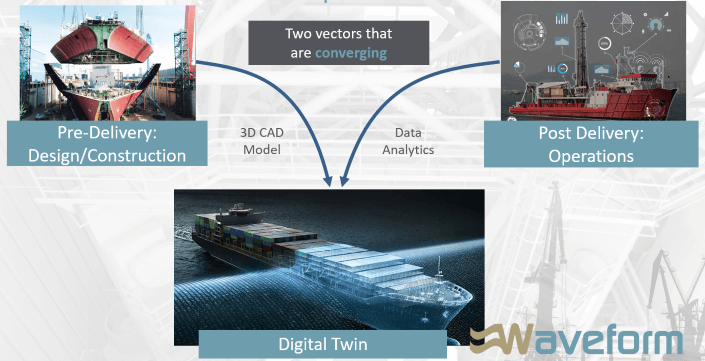The common manufacturing industry definition of a digital twin is a “Current digital representation of a physical asset.” That is an ok high-level definition, but there is still a lot of confusion and disagreement when you dig a little deeper with what a digital twin is for our industry.
For me, a digital twin captures and links all the digital information of a particular asset from all phases of the asset’s lifecycle. A digital twin is not built up at one particular phase. That is why, through the entire lifecycle of a vessel, we are building up the digital twin. It can be argued that the digital twin only comes “alive” or into existence when the physical asset is made; however, it would be impossible to start building the digital twin if we waited until this point. Through the entire lifecycle we need to build up the digital twin so when the asset finally exists in the real world, we also have the digital twin.
It is important for us to understand that through the entire lifecycle of the asset we are either consuming information from the digital twin or we are producing information to add to our digital twin.
Appearance of “Different” Conversations about the Digital Twin

The digital twin is an encompassing idea that can solve many business challenges. This grandiose concept results in articles, conversations and presentations that sometimes seem to be talking about completely different things. The reason for this seemingly diverse dialogue is because they are talking about the digital twin from their own perspective of how it solves their business challenges – as they should. It is important for us to understand that even though they may seem to be talking about something completely different, it is really that they are focusing on a specific aspect of the digital twin which is most important or relevant to them.
At a high level, I find that there are two different trajectories that digital twin conversations revolve around, depending on if the person is more in line with pre-delivery phases or post-delivery phases.
Pre-Delivery Phase (Concept, Design, Engineering, Manufacturing, etc.)
Individuals in the pre-delivery phase usually talk about the digital twin as it revolves around the 3D CAD model. The digital twin is much more than the CAD model, but it seems to be the centerpiece at the majority of discussions. This is where you will hear ideas such as the digital twin is similar to the “As Built” model that we have been talking about for decades, as well as concepts such as Model Based Enterprise (MBE) as a solution for the digital twin.
Post-Delivery Phase (Operations, Maintenance, etc.)
Individuals more involved in the post-delivery of an asset usually talk about the digital twin from a data analytics, IoT, or artificial intelligence perspective.
The drive for more cost effective IoT devices, and even IoT platforms, has really given the visibility of how valuable digital twin can be for operations. This has contributed to why the digital twin has been elevated in the last few years, even though the digital twin has been around for decades.
The Same Digital Twin
Even though it may seem that there are different conversations around the digital twin, it is important to understand that they are talking about the same thing. Both conversations are really related and dependant on one another. For example, in the pre-delivery discussions, to really get the most of their digital twin (CAD, non-CAD, meta-data, etc.) they would need operations to leverage their information. Post-delivery stakeholders need to have the information defined in the pre-delivery phases so that they know the assets they are monitoring.
Closing Remarks
Because the digital twin is a big concept spanning the entire lifecycle of our asset, there is a good possibility that conversations around the digital twin will seem to be talking about completely different things. The reason is due to the fact that the person or company is talking about the digital twin from the business challenges that it will solve for them, which may not be the same business challenge you will be focused on when leveraging the digital twin.
Even though a lot of marketing surrounding the digital twin positions it as the “silver bullet,” we should not and cannot lose sight that the digital twin is just one of the “How’s” we will use to overcome many of our challenges. It is extremely important for us to understand that that we are solving real business problems with the digital twin, so building the digital twin just for the sake of having a digital twin will add little value to our company. As with everything we do in business, we need to start with the business goal first.

